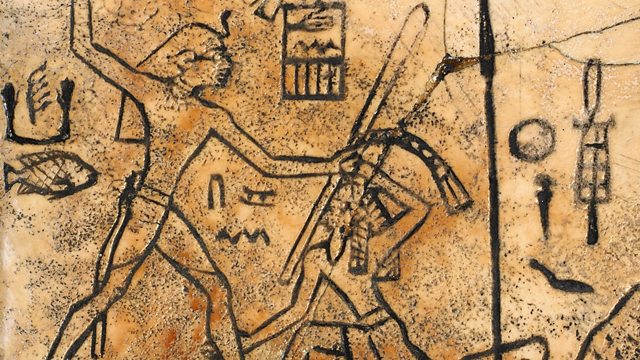The First Cities and States (4000 - 2000 BC)
Another chance to hear the Director of the British Museum retell the history of human development with 100 selected objects from the Museum. This week - the world's first cities.
Neil MacGregor, the Director of the British Museum, presents an omnibus edition of five further items in his history of humanity as told through the objects it has made. Today he investigates the impact on human society of large numbers of people coming together in the world's first cities between 5000 and 2000 BC. As they did so, they developed new trade links, the first handwriting, and new forms of leadership and beliefs.
All of these innovations are present in Neil's first object; a small label made of hippo ivory that was attached to the sandal that one of the earliest known kings of Egypt, King Den, took his grave. The label not only depicts the king in battle against unknown foes but also boasts the first writing in this history of the world - hieroglyphs that describe the king and his military conquests. Is this just the first indication that there would never be civilisation without war
For his second item, Neil considers a set of mosaics from the ancient Mesopotamian city of Ur, now in Southern Iraq. The Standard of Ur shows powerful images of battle and regal life and remains remarkably well preserved given its fourand a half thousand year old history. Contributors include sociologist Anthony Giddens, on the growing sophistication of societies at this time, and the archaeologist Lamia Al-Gailani who considers what Ancient Mesopotamia means to the people of modern day Iraq.
Neil then moves on to the ancient city of Harappa which lies around 150 miles north of Lahore in Pakistan. It was once one of the great centres of a civilisation that has largely disappeared, one with vast trade connections and boasting several of the world's first cities. At a time when another great civilisation was being forged along the banks of the river Nile in Egypt, Neil MacGregor investigates this much less well-known civilisation on the banks of the Indus Valley. He introduces us to a series of little stone seals that are four-and-a-half thousand years old, covered in carved images of animals and probably used in trade. The civilisation built over100 cities, some with sophisticated sanitation systems, big scale architecture and even designed around a modern grid layout. The great modern architect Sir Richard Rogers considers the urban planning of the Indus Valley, while the historian Nayanjot Lahiri looks at how this lost civilisation is remembered - by both modern India and Pakistan.
In Britain, at that time, life was much simpler, although trade links with Europe were well established. For his next item, Neil tells the story of a beautiful piece of jade, shaped into an axe head. It is about 6000 years old and was discovered near Canterbury in Kent but was made in the high Alps. He tells the story of how this object may have been used and traded and how its source was cunningly traced to the heart of Europe
And for his final item in this programme, Neil celebrates the arrival of writing into our history - with a 5000 year old clay tablet from Mesopotamia that deals not in poetry but in describing the local beer. The philosopher John Searle describes what the invention of writing does for the human mind and Britain's top civil servant, Gus O'Donnell, considers the tablet as an example of possibly the earliest bureaucracy
Last on
Broadcasts
- Fri 19 Mar 2010 21:00大象传媒 Radio 4
- Sun 4 Dec 2011 17:00大象传媒 Radio 4 Extra

